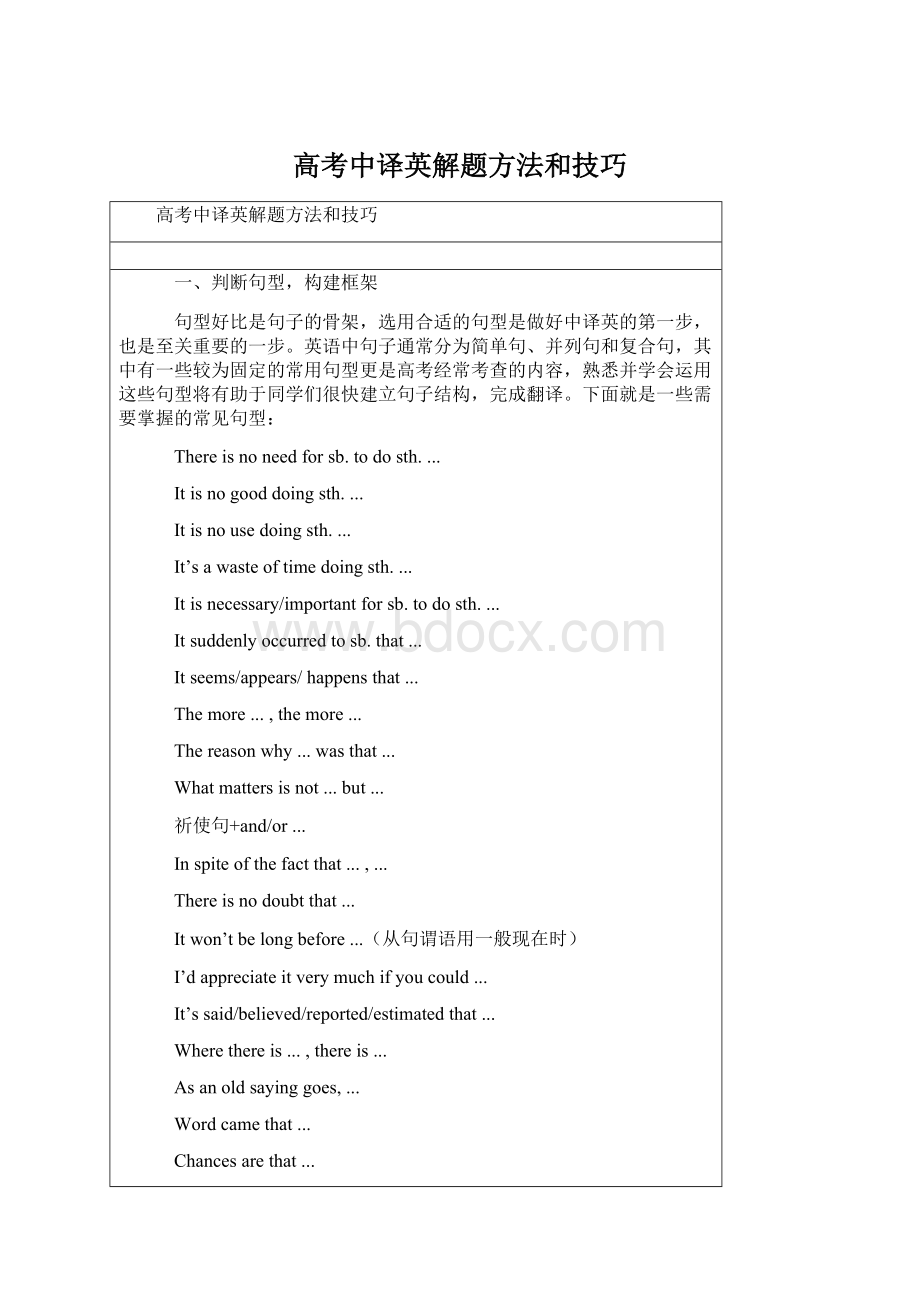高考中译英解题方法和技巧文档格式.docx
《高考中译英解题方法和技巧文档格式.docx》由会员分享,可在线阅读,更多相关《高考中译英解题方法和技巧文档格式.docx(13页珍藏版)》请在冰豆网上搜索。

Themore...,themore...
Thereasonwhy...wasthat...
Whatmattersisnot...but...
祈使句+and/or...
Inspiteofthefactthat...,...
Thereisnodoubtthat...
Itwon’tbelongbefore...(从句谓语用一般现在时)
I’dappreciateitverymuchifyoucould...
It’ssaid/believed/reported/estimatedthat...
Wherethereis...,thereis...
Asanoldsayinggoes,...
Wordcamethat...
Chancesarethat...
Itremainstobeseenwhether...
(Itis)nowonderthat...
Itistakenforgrantedthat...
Itisknowntoallthat...
Ittakessb.sometimetodosth....
...so...that...
Besuretodo...
Itiscertainthat...
AistoBwhatCistoD.
Itmakesnodifferencewhether...
Italldependsonsb./sth.whether...
...makesitaruletodosth....
Makesurethat...(从句谓语用一般现在时)
二、把握关键词,熟悉短语搭配
历年高考中译英题的考核点中,短语搭配占了很大的比重,其中动词短语尤为重要。
正确使用关键词,用好短语搭配,往往会使难题迎刃而解。
下面是近几年高考出现的短语考点:
1.我们将作进一步的讨论,然后再作出最终结论。
(before)(2001年高考)
Wewillhaveafurtherdiscussionbeforewedrawafinalconclusion.
2.当时,那位出租车司机别无选择,只能求助于顾客。
(choice)(2002年高考)
Atthattime,thetaxidriverhadnochoicebuttoturntothetourist(forhelp).
3.这条铁路横贯平原,把那个偏远山城与海港连接了起来。
(remote)(2003年高考)
Therailwaycrossestheplainandconnectstheremotemountaincitywiththeseaport.
4.你该就刚才的所作所为向在场的人道歉。
(apologize)(2004年高考)
Youshouldapologizetothepeoplepresentforwhatyouhavejustdone.
5.多吃蔬菜和水果有益健康。
(good)(2005年高考)
Eatingmorevegetablesandfruitsdoesgoodtoone’shealth.
6.我忘了提醒他面试的时间。
(remind)(2007年高考)
Iforgottoremindhimofthetimefortheinterview.
三、了解汉英差异,避免误入陷阱
1.连词
中文中,“因为……所以……”“虽然……但是……”“除非……否则……”等常用来表示因果、转折等关系。
但是在英语中,不能同时使用并列连词和状语从句的连词。
例如:
除非采取紧急措施,否则我们的计划将流产。
Unlesswetakeurgentmeasures,orourplanwillbespoiled.(?
菖)
Unlesswetakeurgentmeasures,ourplanwillbespoiled.(?
菁)
他尽管双目失明,却没有放弃作家梦。
Althoughhewasblindinbotheyes,buthedidn’tgiveuphisdreamofbeingawriter.(?
Althoughhewasblindinbotheyes,(yet)hedidn’tgiveuphisdreamofbeingawriter.(?
2.语态
在中英不同的语言文化中,主动和被动的表达存在着一定的差异。
有时中文看似主动,译成英语却应用被动形式;
有时中文是被动的意思,在英语中却用主动形式。
以下情形中常用英语的主动形式表示中文的被动意思:
(1)某些连系动词(如look,sound,smell,feel,taste,prove等)要用英语主动形式表中文被动意义。
他告诉我的事情被证实是真的。
Whathetoldmeprovedtobetrue.
(2)当read,wash,sell,clean,cook,cut,wear,carry等用作不及物动词且表示主语的某种属性时,通常要用英语主动形式表示中文被动意义。
这本书被卖得很快。
Thebooksellsquickly.
(3)当open,close,shut,lock,move等用作不及物动词且表示主语的某种属性时,通常用英语主动形式表示中文被动意义。
这门关不上。
Thedoorwon’tshut.
(4)某些“be+形容词+todo”结构中的不定式通常要英语用主动形式表示中文被动意义。
这篇学术论文很难被翻译过来。
Theacademicarticleisdifficulttotranslate.
(5)beworth后的动名词要用英语主动形式表中文被动意义。
这可能值得考虑。
Thismightbeworththinkingabout.
(6)在need,want,require等少数表示“需要”的动词后接动名词用主动形式表被动意义。
这些植物得天天浇水。
Theplantsneedwateringeveryday.
也有很多情况下,英语的被动形式表示中文的主动含义。
这时很多同学就可能会忽略被动语态的使用。
坐在树下的人是我叔叔。
Themanwhowasseatedunderthetreeismyuncle.
这样的例子不胜枚举,同学们在练习时应注意多积累和总结。
3.语序
在某些情况下,英语的主谓必须全部或部分倒装。
有时为了保持句子平衡,各部分顺序会发生颠倒,这与中文表达顺序有所不同。
我们的祖国从来没有像今天这样强大过。
(Never)
Neverbeforehasourcountrybeenaspowerfulasitistoday.
老师仅靠一支粉笔上课的日子一去不复返了。
(Gone)
Gonearethedayswhenateachergavelessonsonlywithapieceofchalk.
我认为你找不到自行车了。
Idon’tthinkyoucanfindyourbicycle.
4.标点符号
汉语中的某些标点符号是英语没有的。
例如英语中没有顿号(、),常用逗号充当并列连接作用。
英语中也没有书名号(《》),汉语用于书名、报刊杂志名的书名号,英语中常用斜体字代替。
有些标点符号的汉英表示形式是不同的。
例如在汉语中句号是以空心圆(。
)来表示的,在英语中是实心点(.)。
又如汉语中的省略号是居中的六点(……),英语是用位于底部的三点(...)来表示。
同学们在使用这些符号时要特别注意,防止混淆。
四、理解成语与俗语,无须字字对译
近年的高考中译英题中,总会出现一些比较地道的中文或常用的成语,许多同学对于这些成语和俗语的翻译常不知所措。
此时,同学们不妨冷静下来,从成语的实际意义入手,在理解的基础上,用适当的英语表达出来,完全不必字字对译。
有些成语和俗语的中英文是基本对应的,例如欣喜若狂(bewildwithjoy),熟能生巧(practicemakesperfect)等。
但大多数还是需要通过意译的方法来表达。
以近年的高考试题为例:
1.请尽早作出决定,不然你会坐失良机。
(or)(2003年高考)
Pleasemakeupyourmind/makeyourdecisionasearlyaspossible,oryou’llmissthegood/goldenchance/opportunity.
2.这个游戏的规则太复杂,三言两语解释不清。
(too...to)(2004年高考)
Therulesofthegamearetoocomplicatedtoexplain/beexplainedinafewwords.
3.他进公司后不久就独立完成了一项艰巨的任务,同事们对他刮目相看。
(so)(2005年高考)
Hefinishedadifficulttaskonhisown/independentlysoonafterheenteredthecompany,sohiscolleagueslooked